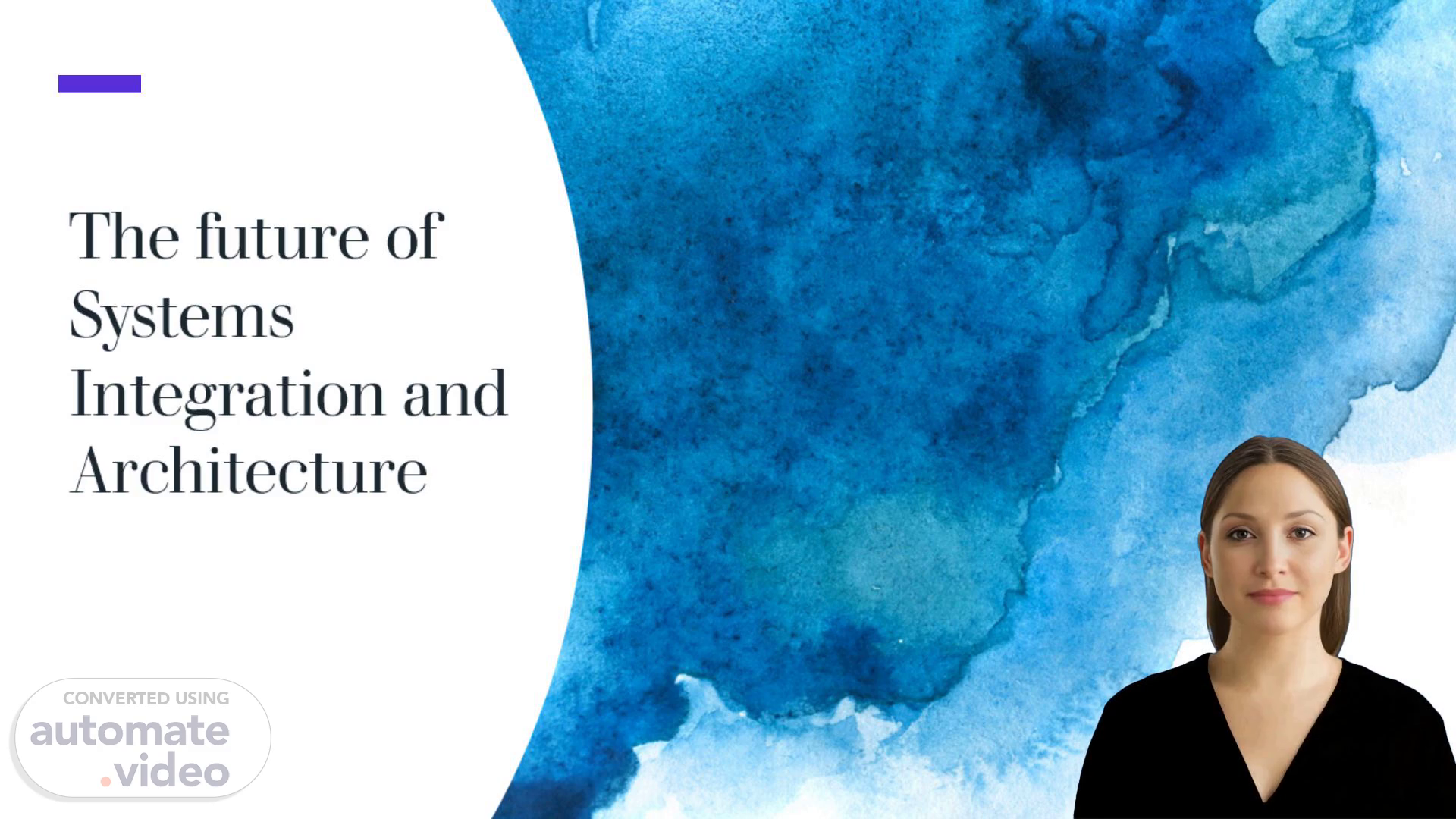
Page 1 (0s)
[Virtual Presenter] Good afternoon everyone. We are here today to discuss the future of Systems Integration and Architecture. In this presentation, we will explore the various aspects of this important topic and examine how it can help organizations become more efficient and effective. We will also look at the challenges that organizations face. So, let's get started and dive into the world of systems integration and architecture..
Page 2 (30s)
[Audio] When it comes to systems integration and architecture, a major factor to consider is the capability of various information systems to communicate with each other. This interconnecting network between systems allows them to transfer data and information, thus making sure the whole system is coordinated and connected. By establishing this connection, information systems can work together seamlessly and productively..
Page 3 (57s)
[Audio] EAI, short for Enterprise Application Integration, is an essential part of Systems Integration and Architecture. As organizations increasingly rely on technology, EAI has become increasingly important. It is a methodology of enabling communication between different systems, allowing them to effectively exchange data and interact. This leads to integrated systems that are capable of improving operational efficiency, customer experience, and gaining a competitive edge..
Page 4 (1m 32s)
[Audio] Concepts of systems integration and architecture are vital for the success of any enterprise. Enterprise architectures enable a broad range of systems and applications to cooperate in order to provide the business with the services necessary to make them successful. This offers a unified perspective of their IT infrastructure and enables any modifications or updates to be processed in an organized, controlled fashion. This guarantees that the company is utilizing their resources effectively and that their IT systems are continually up-to-date..
Page 5 (2m 8s)
[Audio] The term silos is a metaphor used to describe the lack of communication and collaboration between different departments in an organization. This can lead to inefficient processes and operations, along with bottlenecks and delays, negatively impacting an organization's time and money. To prevent this, it is essential to understand the concept of silos and how to break them down..
Page 6 (2m 34s)
[Audio] Two approaches to System Integration are explored in this slide, namely Vertical Integration and Star Integration. Vertical Integration involves forming distinct functional entities or silos, while Star Integration entails connecting each system to the other subsystems. Horizontal Integration is when a specific subsystem is devoted to communication between other subsystems, for instance an Enterprise Service Bus (ESB). In addition, employing a shared data format, such as Enterprise Application Integration (EAI) systems, eliminates the need to build adapters to join up the different applications..
Page 7 (3m 16s)
[Audio] It is clear that information systems will remain a key element of any successful organization in the future of systems integration and architecture. Information systems are needed for both primary and secondary activities as well as the organization's value chain in order to meet the rapidly growing information needs of the organization. They are essential for areas such as accounting, finance, marketing, customer service, human resource management, operations, and manufacturing as well as for the analytical and decision-making of strategic, middle, and operational levels of management. Therefore, information systems are unavoidable for a successful enterprise..
Page 8 (4m 1s)
[Audio] System architecture is a structure and components of a system that have been created to achieve a certain goal. This architecture is formed through the components of the system and their interactions, representing the system in such a way that its structure and behaviour can be inferred. To more accurately represent system architecture, there are languages known as Architecture Description Languages (ADLs). Linking back to systems integration and architecture, this setup allows a system to be designed with an optimal integration of components and measurements..
Page 9 (4m 37s)
[Audio] Starting from the definition and specification of requirements, the system integration life cycle has several distinct phases. We can analyze the feasibility of what is being proposed and develop a system architecture with a management plan. Design phase follows and involves both logical and physical design. Implementation is after that, bringing the design to life, testing and deploying it for operational use. Lastly, evaluating the system and planning any necessary replacements is done..
Page 10 (5m 13s)
[Audio] The system integration life cycle is of paramount importance in the creation of tailored, dependable and secure systems. It starts with the design phase which details the system's specifications. After that, the development phase builds and tests the system components, followed by the facilities engineering phase where the physical environment is prepped. The implementation stage then makes the system operational, and the post-implementation support phase provides long-term maintenance and improvements. With this life cycle in place, the future of systems integration and architecture is certainly looking positive..
Page 11 (5m 55s)
[Audio] It is important to note that system architecture is a growing profession. Systems architects are highly skilled computer professionals that are essential in designing, implementing and maintaining databases and complex computer systems. They act as a bridge between technical solutions and business objectives, and are able to maximize quality and efficiency throughout computer networks or systems. Let us recognize this critical profession and the hard work they do to ensure the success of our technological infrastructure. Thank you..